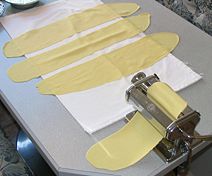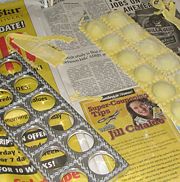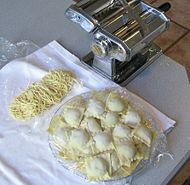Alkaline pasta: Difference between revisions
imported>Milton Beychok m (Simple addition of a line space lets the last image to truly center.) |
imported>Hayford Peirce (did Milt's first suggestion, the subs for numbers) |
||
| Line 4: | Line 4: | ||
{{Image|Alkaline Pasta2.jpg|right|180px|Making ravioli with a recipe from the Don Camillo restaurant in [[Nice]].}} | {{Image|Alkaline Pasta2.jpg|right|180px|Making ravioli with a recipe from the Don Camillo restaurant in [[Nice]].}} | ||
'''Alkaline pasta''', or '''alkaline noodles''', is a variation of standard Chinese or Italian noodles in which a much higher than usual quantity of an [[alkaline]] component is part of the fabrication process. This is usually achieved by the introduction of [[sodium carbonate]] ( | '''Alkaline pasta''', or '''alkaline noodles''', is a variation of standard Chinese or Italian noodles in which a much higher than usual quantity of an [[alkaline]] component is part of the fabrication process. This is usually achieved by the introduction of [[sodium carbonate]] (Na<sub>2</sub>CO<sub>3</sub> or sodium salt of carbonic acid) into the primary ingredients. In parts of China in which alkaline wheat noodles are common, traditional ones are made with alkaline water from wells. More commonly a mixture of sodium carbonate, which is also an anti-caking agent, and potassium carbonate is added directly. This mixture is what the Chinese call "jian" and what the Japanese call "kansui"; it is best known in the West for the [[ramen]] soup noodles from Japan that use it. <ref>''The Curious Cook: Achieving a Distinct Flavor, Without Going to Extremes'', by Harold McGee, in the ''New York Times'' "Dining" section of Wednesday, September 15, 2010, at [http://query.nytimes.com/gst/fullpage.html?res=9F02E7DD1E3BF936A2575AC0A9669D8B63&scp=1&sq=achieving%20a%20distinct%20flavor%20without%20going%20to%20extremes&st=cse]</ref> | ||
The addition of alkaline materials to such dishes as pasta makes them feel slippery in the mouth and on the fingers; they also develop a yellow color and are more elastic than ordinary noodles. Various flours such as ordinary all-purpose white flour, bread flour, and semolina flour can be used, with somewhat varying results. <ref>''The Curious Cook: Achieving a Distinct Flavor, Without Going to Extremes'', by Harold McGee, in the ''New York Times'' "Dining" section of Wednesday, September 15, 2010, at [http://query.nytimes.com/gst/fullpage.html?res=9F02E7DD1E3BF936A2575AC0A9669D8B63&scp=1&sq=achieving%20a%20distinct%20flavor%20without%20going%20to%20extremes&st=cse]</ref> Noodles prepared in this manner are actually akin to the gelatinous Scandinavian specialty known as [[lutefisk]], which uses [[lye]], a far more powerful agent. | The addition of alkaline materials to such dishes as pasta makes them feel slippery in the mouth and on the fingers; they also develop a yellow color and are more elastic than ordinary noodles. Various flours such as ordinary all-purpose white flour, bread flour, and semolina flour can be used, with somewhat varying results. <ref>''The Curious Cook: Achieving a Distinct Flavor, Without Going to Extremes'', by Harold McGee, in the ''New York Times'' "Dining" section of Wednesday, September 15, 2010, at [http://query.nytimes.com/gst/fullpage.html?res=9F02E7DD1E3BF936A2575AC0A9669D8B63&scp=1&sq=achieving%20a%20distinct%20flavor%20without%20going%20to%20extremes&st=cse]</ref> Noodles prepared in this manner are actually akin to the gelatinous Scandinavian specialty known as [[lutefisk]], which uses [[lye]], a far more powerful agent. | ||
Revision as of 10:38, 3 October 2010
Alkaline pasta, or alkaline noodles, is a variation of standard Chinese or Italian noodles in which a much higher than usual quantity of an alkaline component is part of the fabrication process. This is usually achieved by the introduction of sodium carbonate (Na2CO3 or sodium salt of carbonic acid) into the primary ingredients. In parts of China in which alkaline wheat noodles are common, traditional ones are made with alkaline water from wells. More commonly a mixture of sodium carbonate, which is also an anti-caking agent, and potassium carbonate is added directly. This mixture is what the Chinese call "jian" and what the Japanese call "kansui"; it is best known in the West for the ramen soup noodles from Japan that use it. [1]
The addition of alkaline materials to such dishes as pasta makes them feel slippery in the mouth and on the fingers; they also develop a yellow color and are more elastic than ordinary noodles. Various flours such as ordinary all-purpose white flour, bread flour, and semolina flour can be used, with somewhat varying results. [2] Noodles prepared in this manner are actually akin to the gelatinous Scandinavian specialty known as lutefisk, which uses lye, a far more powerful agent.

Cooking a dozen ravioli, with warmed sauce made from braised oxtail ready to add.
Harold McGee, a well-known American food scientist and author, has drawn on the experience of such noted chefs as David Chung, owner of the Momofuku line of restaurants, [3] and Fuchsia Dunlop of London, to outline a simple method by which home chefs can make alkaline noodles.
A few tablespoons of ordinary baking soda are spread out in a thin layer on a cookie sheet and baked in a 300-degree oven for an hour. Baking soda is sodium bicarbonate; by baking it, water and carbon dioxide are exuded and what is left is alkaline-enough to cause discomfort if touched to the skin.[4] A very small of amount of the baked soda is used in the preparation of McGee's pasta dish, only 1 teaspoon to 1-1/2 cups of semolina flour, but it is enough. When preparing the pasta, the soda is first dissolved in a small quantity of water, which is then slowly added to the semolina. Afterwards, the kneaded dough is allowed to rest for an hour and is then rolled out very thin through a pasta machine and processed into the desired form of noodles. The unused portion of the baked soda can be stored in a tightly sealed bottle and kept for future use.
References
- ↑ The Curious Cook: Achieving a Distinct Flavor, Without Going to Extremes, by Harold McGee, in the New York Times "Dining" section of Wednesday, September 15, 2010, at [1]
- ↑ The Curious Cook: Achieving a Distinct Flavor, Without Going to Extremes, by Harold McGee, in the New York Times "Dining" section of Wednesday, September 15, 2010, at [2]
- ↑ See a list, and explanation, of many exotic ingredients used by Chung at [3]
- ↑ "Alkaline materials come in different strengths," writes McGee. "Lye is especially strong and corrosive because it's a simple combination of sodium and hydroxyls. A weaker group of alkalis is the carbonates, which include baking soda. The carbonates don't contain hydroxyls. Instead they soak up protons, and release hydroxyls from water molecules. Baking soda is sodium bicarbonate, which already includes one proton and so has a limited ability to take up more. But if you heat baking soda, its molecules react with one another to give off water and carbon dioxide and form solid sodium carbonate, which is proton-free."



